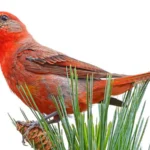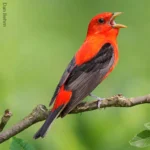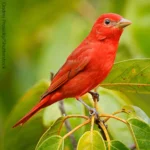Although only four tanager species are found in the United States, these birds hold a special place in the hearts of many thanks to their dazzling plumage. Given these vivid colors, and the fact that most U.S. tanagers occur here only seasonally, it may come as no surprise that these are warm-weather birds. Excepting the Hepatic Tanager, which maintains a small year-round toehold in southern Arizona, all retreat to Mexico, Central, or South America during winter months.
While none of our tanagers can claim a coast-to-coast breeding range in the U.S., several occupy large regions and, taken as a whole, one tanager or another can be found throughout most of the continental U.S. Seeing them, however, isn’t always easy. Even the most brilliantly colored of the group, the Scarlet Tanager, can be elusive given its preference for high forest canopies.

Hepatic Tanager. Photo by Greg Homel/Natural Elements Productions
Tanagers in Name Only
Despite the name, tanagers found in the U.S. aren’t really tanagers — at least not scientifically speaking. Based on DNA analysis, scientists recently placed members of the Piranga genus (including the species listed here) in the Cardinalidae family. These tanagers, it turns out, have more in common with cardinals than with true tanagers (Thraupidae), which inhabit the tropics.
In spite of the fact that Cardinalidae and Thraupidae families descend from different branches of the avian family tree, they share several similarities. The first is ecology. A number of species in both groups have evolved to occupy similar ecological roles. More evident to casual observers, though, are their flashy colors.
Cardinalidae Tanagers
Tanagers in the Cardinalidae family are medium-sized songbirds with several key traits. All sport bright red, orange, or yellow plumage. They like to stay high, inhabiting treetops; they are less social than many other birds, even on their breeding grounds; and they are mainly insectivores, picking insects off leaves or snatching them in mid-flight.
Our List of U.S. Tanagers
The alphabetical list below includes all tanagers that breed regularly in the U.S. and Canada. For this reason, we excluded the Flame-colored Tanager, a vagrant from Mexico and Central America, due to its rarity. The Partners in Flight population and conservation data we use is exclusive to the U.S. and Canada and does not reflect global numbers.
Hepatic Tanager
|
Scarlet Tanager
|
Summer Tanager
|
Western Tanager
|
Tanager Conservation
Most tanagers, like other Neotropical migrants, benefit from the conservation and restoration of large forested areas on their North American breeding grounds. Conservation of sufficient forest habitat along major migratory corridors and on wintering grounds is another high-priority management strategy.
ABC and its regional partners in the United States, the Migratory Bird Joint Ventures, manage upwards of 6 million acres for birds, including both public and private lands. Several of these joint ventures, such as the Appalachian Mountains Joint Venture, are responsible for ongoing habitat conservation projects that directly benefit breeding tanagers in the U.S.
How Can I Help?
Working with partners throughout Latin America, ABC has helped to establish a network of bird reserves that span over 1 million acres in 15 countries. These reserves protect remaining habitat for rare tropical birds as well as critical wintering grounds for migratory species, including several of the tanagers listed above. Keeping this reserve network strong and growing is a major undertaking, and you can help by making a gift today.

Western Tanager. Photo by Tim Zurowski/Shutterstock
If you enjoy coffee, you can support bird conservation efforts by buying certified Bird-Friendly coffee, which is grown on farms that meet several stringent criteria and provide wintering habitat for tanagers and other migratory species. For example, Colombia’s Cerulean Warbler Reserve, which was created with ABC support, includes a 37-acre shade-grown coffee plantation that helps cover the reserve’s operating costs.



